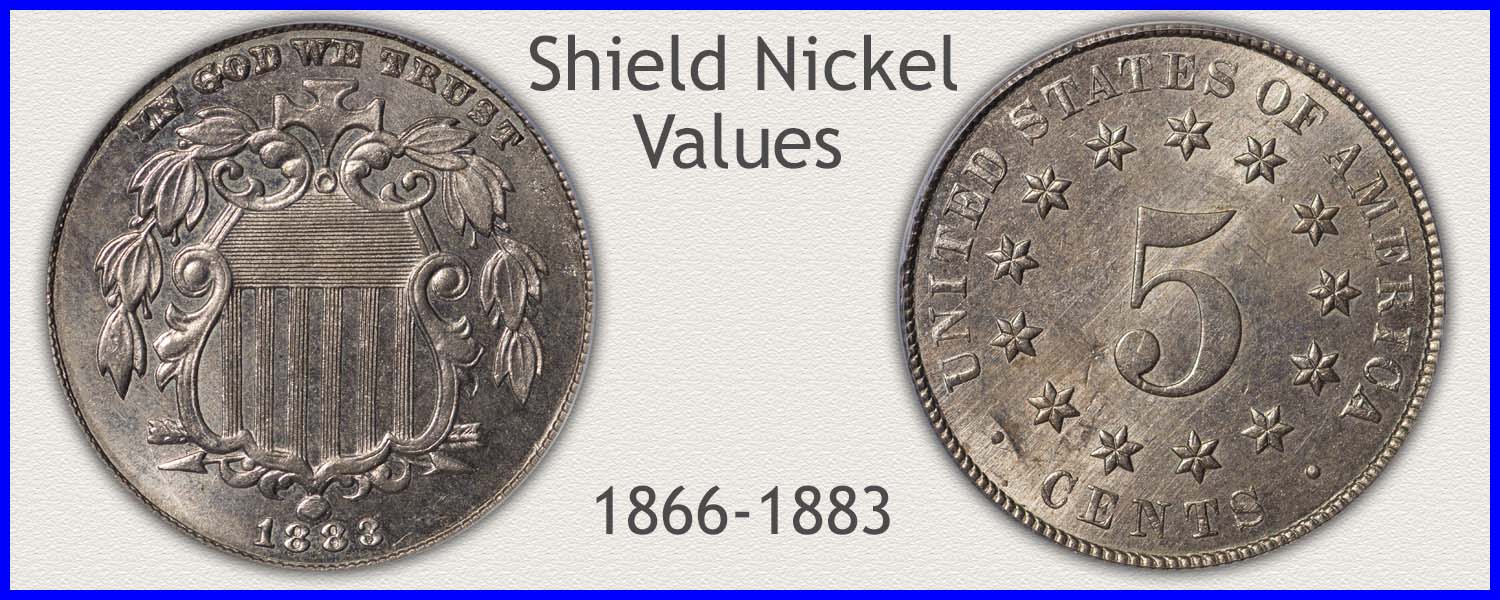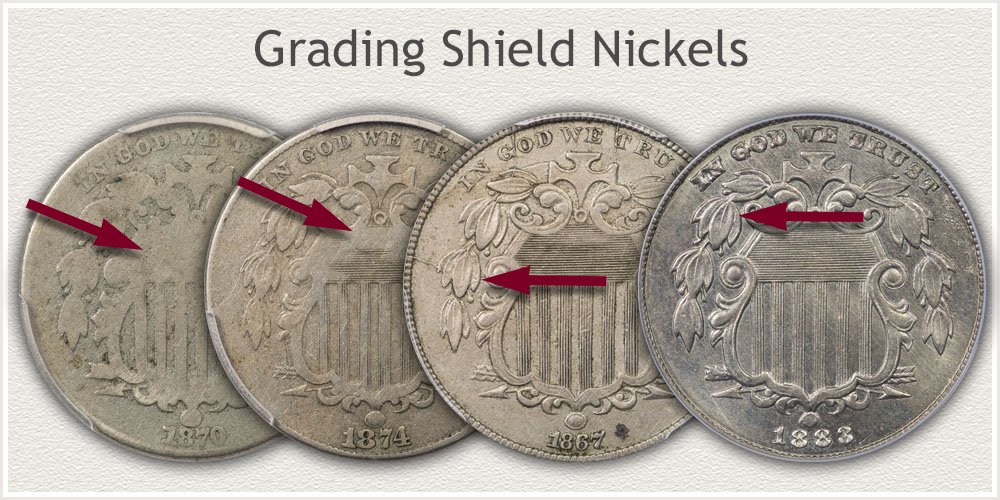Coin Values Moving with Precious Metals: Up-Dated 12/8/2025: Gold $4212 | Silver $58.12
1866 Nickel Value
1866 nickel value reflects its historic place in U.S. coinage. This is the first year of a five-cent piece using a nickel-copper metal alloy. Today, the coin hobby refers to these as a Shield nickel. There is always a demand in the market for the coin. Its initial value reflects this strong demand.
In addition to its date, many factors add to its appeal among collectors. A step-by-step process covers these key features when evaluating the coin. Of importance, recognizing one in above average preservation. Step 2 judges a coin's condition in detail.
Start with a review of the chart listing a range of how much an 1866 nickel is worth.
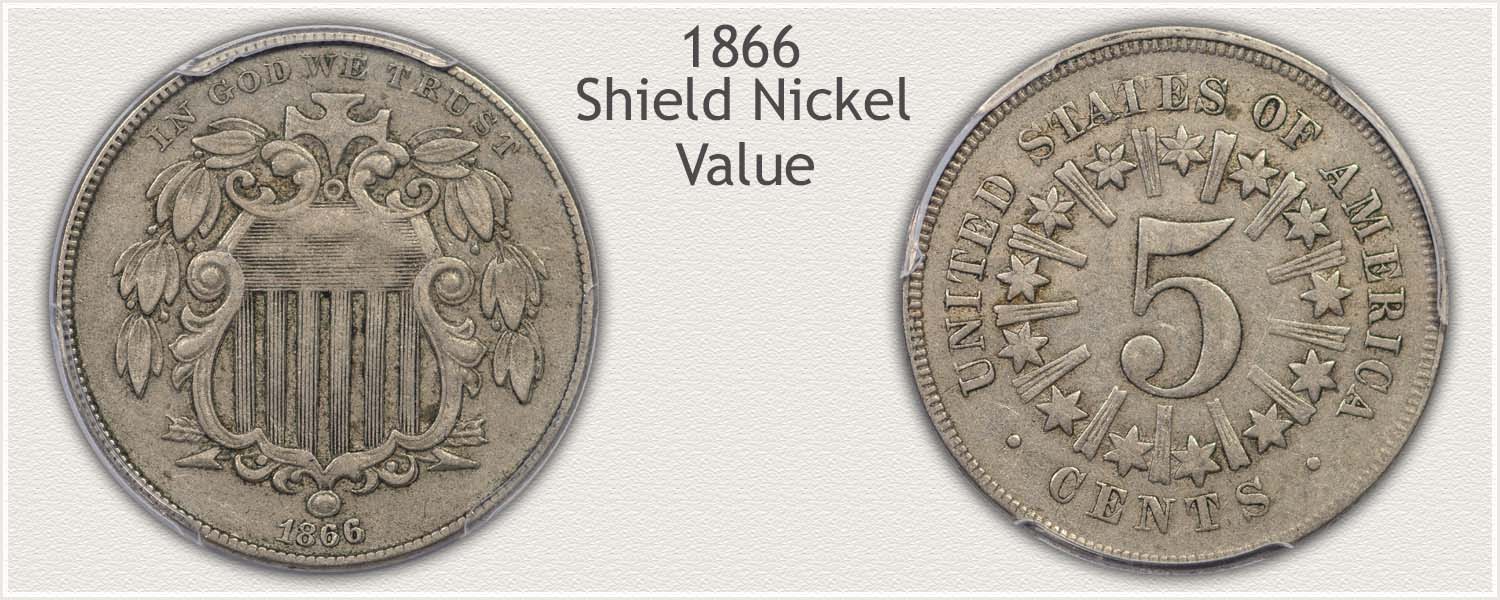
Steps Leading to Value:
- Step 1: Date Identified - Double check this important date in the Shield nickel series.
- Step 2: Grading Condition - Use the coin's large shield design as a gauge and identify important qualities. Many features point to high premiums.
- Step 3: Special Qualities - The coin market shows great interest in "first of" coinage. Two significant qualities support a solid base for demand and value of this year.
| 1866 Nickel Value | ||||
|---|---|---|---|---|
| Condition of Coin | ||||
| Date | Good | Fine | Extremely Fine |
Mint State |
| 1866 Nickel Value Updated | 2025 | |||
| 1866 | $22 | $48 | $111 | $244 |
Wholesale value chart for 1866 nickels. Listing a range these nickels trade in the market. Note, small changes in condition and preservation result in changes in premiums.
Step 1: Confirm the Date of a Historical Coin
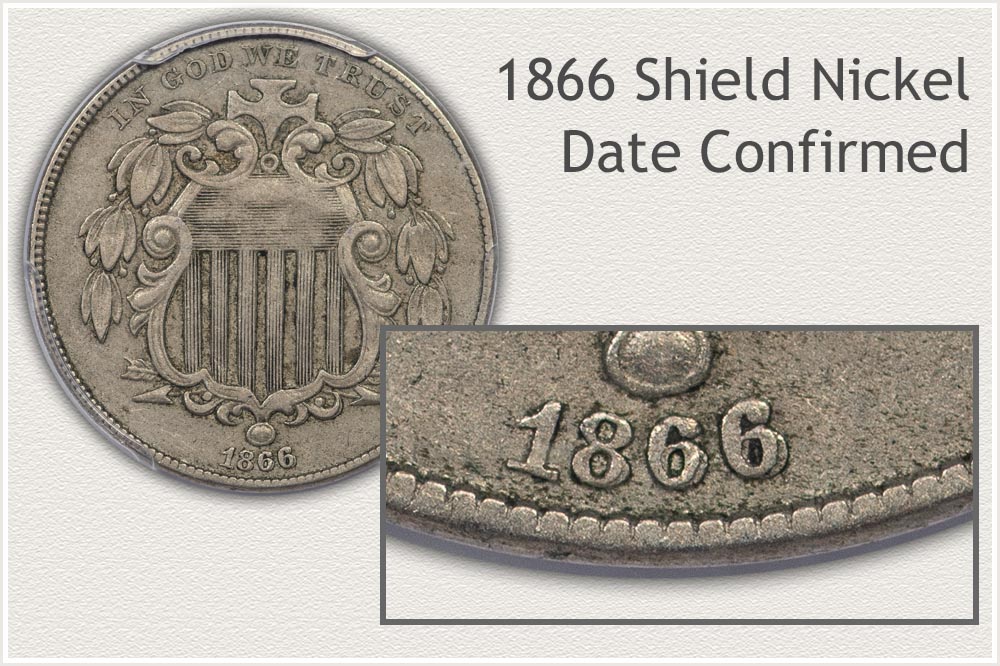
Thanks to ample production of an important year, 1866 nickels are available today. The Philadelphia mint struck 14.7 million nickels in 1866. This number introduced the new nickel alloy five cent denomination to U.S. coinage.
As the first year of a new series, many collectors consider it a "must have" date. Add in the historical significance of a new alloy denomination, and there is a steady demand for the date. Date collections of the series require an 1866. Nickel type collections, one coin of each series, often include this coin as an example of a Shield nickel. Major type collections, one coin from all denominations, seek the coin as well.
The value chart reflects its strong rarity profile. All levels of condition show strong premiums. Coins set aside as "keepsakes" at the time of issue; help supply today's high demand. Confirm and record the date with a second inspection.
Step 2: | With Images as Reference Determine Condition
Grading Narrows 1866 Nickel Value Listed on the Chart
The coin market depends heavily on a coin's condition to determine its value. As a coin circulates, certain patterns of remaining detail develop within the design. Different stages of wear are standardized into Grade ratings. Presented on the chart, grades show a range of values awarded to the coin.
With a magnifying glass and a single light source, inspect the surface of each coin. When comparing the illustrations of different grades, find a close match. Descriptions of each condition highlight specific details required to qualify at grade standards. In 1866, the mint experienced difficulty producing these first-year nickels. Grading a coin's condition accounts for soft struck areas. The descriptions alert to these areas.
Mint State Grade
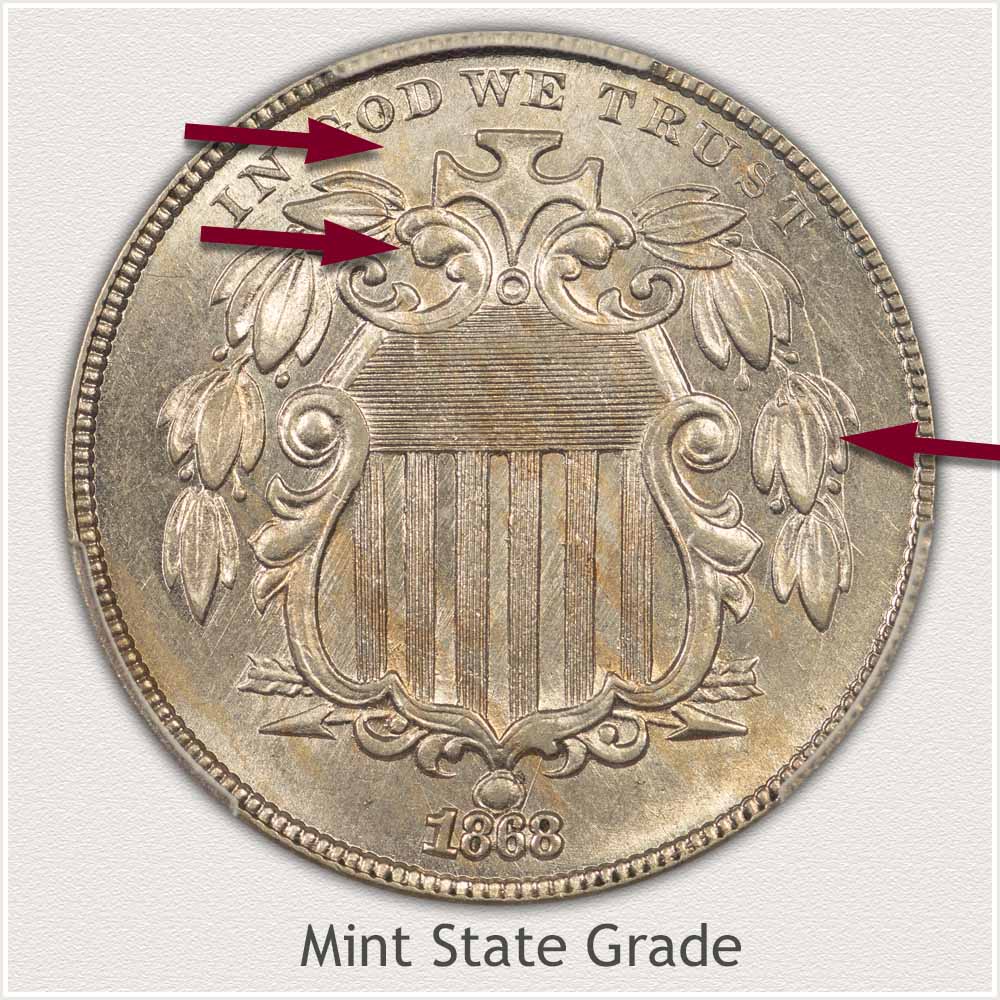
Mint State: Mint State condition nickels are without wear to their surface. This is the primary definition of the Mint State grade. Collectors and the coin market use "Mint State" as a grading term. Grades are a defining part of a full description of a coin and its condition.
One consideration specific to Shield nickels is judge condition on well struck areas. In the example image, this Mint State nickel is well struck on the curved elements atop the shield. This area has high, rounded profiles, lower, recessed areas, and defined edges. All display the original fine grain texture imparted during the striking process. Striking a coin when minted causes metal to "flow." The result is a texture displaying luster under light.
At the top of the shield design, examine both high curves and the field of the coin. Luster and color is similar on each. Wear flattens the tops of the contours and changes how the metal reflects light. Worn metal on a nickel displays a grayish tone and a smooth surface. Subtle differences are detectable when comparing different areas of the surface. A Mint State surface is similar overall. Worn metal displays areas of smoothness, color changes, and contrasts over its surface.
Tilting the coin under a single light brings out the effects of a vibrant original surface. Compared to one with the dullness of a worn surface.
Extremely Fine Grade
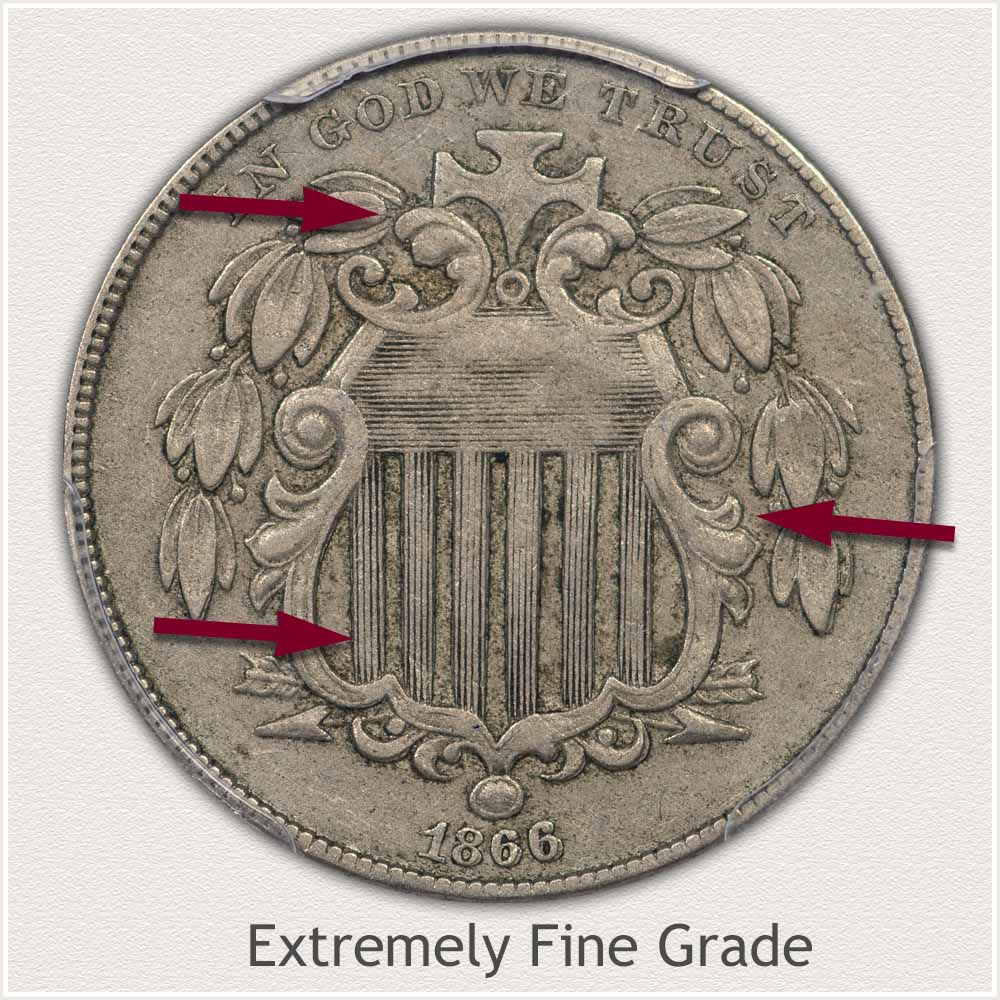
Extremely Fine: A Shield nickel in Extremely Fine grade gives the impression of a highly detailed coin. Defining the condition describes wear as restricted to high points only. These quality nickels enjoy strong value in the coin market. Measuring wear on high relief points of the shield indicates condition when grading.
When examining your coin, compare it to the image of a graded Extremely Fine nickel. Focus on the frame of the shield at the sides of the vertical stripes. A sweeping curve extends below the decorations, connecting to the bottom of the frame. Within this curved element, a raised contour is set between edges and a deep recess. This remains clearly visible and intact on the example coin. A small amount of wear flattens the raised contour, indicating light wear. Evaluate both sides of the frame, one is often better struck. Use the best represented side as the grading point.
Vertical lines become a second area to examine. This design element has raised vertical bars with interior lines. Nearly all lines are complete at the Extremely Fine grade level. In isolated areas, light wear fades the crisp appearance of the lines. Limited merging of lines occurs at one or two small spots. Crisp lines without fading are a premium example of this condition.
Fine Grade
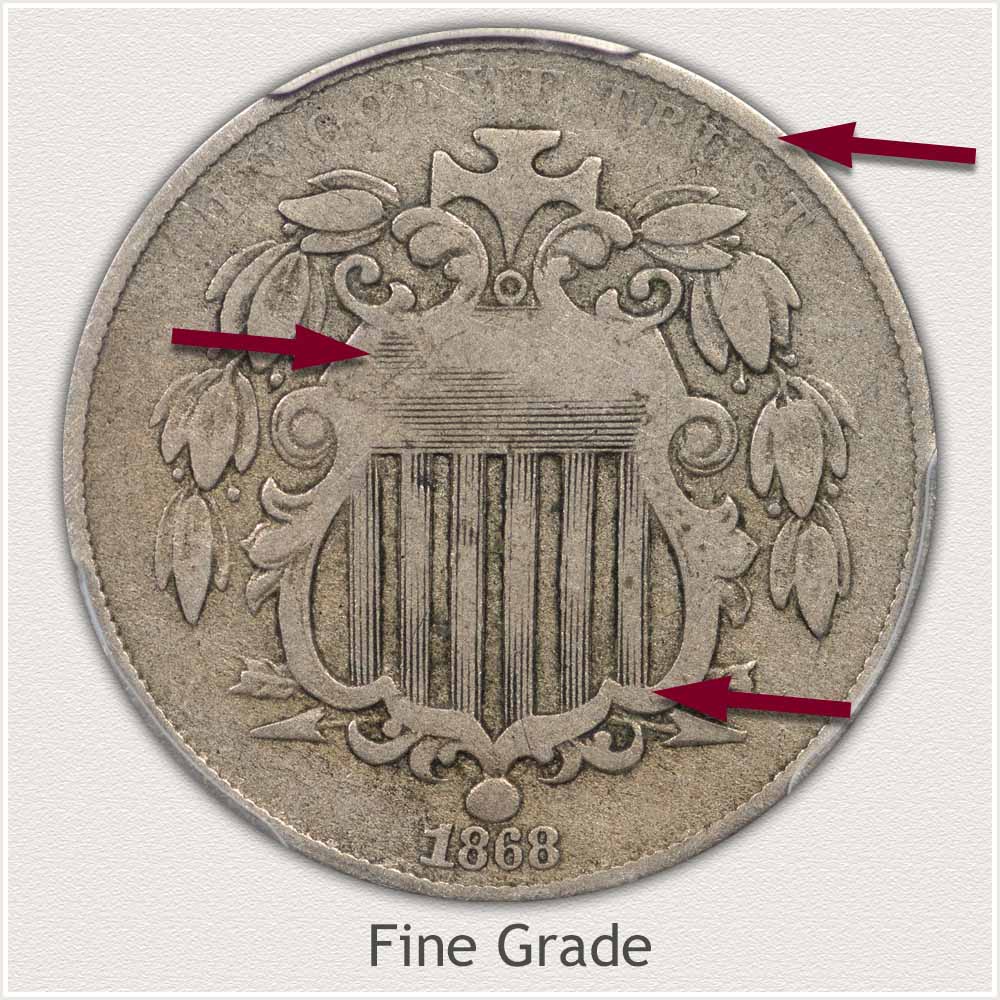
Fine Grade: A Shield nickel in fine grade has large areas of missing detail balanced with areas of fine detail. An overall view of the condition finds a readable motto at the top. A clear date is at the bottom of the coin. In the center, there is a shield and leaves with many visible details. Judging the remaining details on these elements determines the amount of wear.
At the center of the coin, many fine lines, both horizontal and vertical, remain visible. In Fine grade condition, moderate wear defines the grade. To meet the grade quality, at least half of the horizontal lines show clearly. On the example coin, these shield lines visibly record the "moderate" wear amount.
Below the horizontal lines, raised vertical bars form stripes. Within the stripes deep recesses create the fine lines. The smooth areas between the bars are lower, the same height as the field of the coin. These raised, vertical bars are another useful area to gauge wear amounts. Wear removes metal from the top of the bars, eventually to the depth of the recessed lines. As with the horizontal lines, half of the fine vertical lines must remain.
Next, examine where the vertical lines meet the inner edge of the frame at the bottom. The frame in this area is slightly higher than the vertical lines. A defined edge remains on the frame, separating the lines and frame. This subtle detail provides a crisp feature, helping qualify the coin at the Fine grade level.
Good Grade
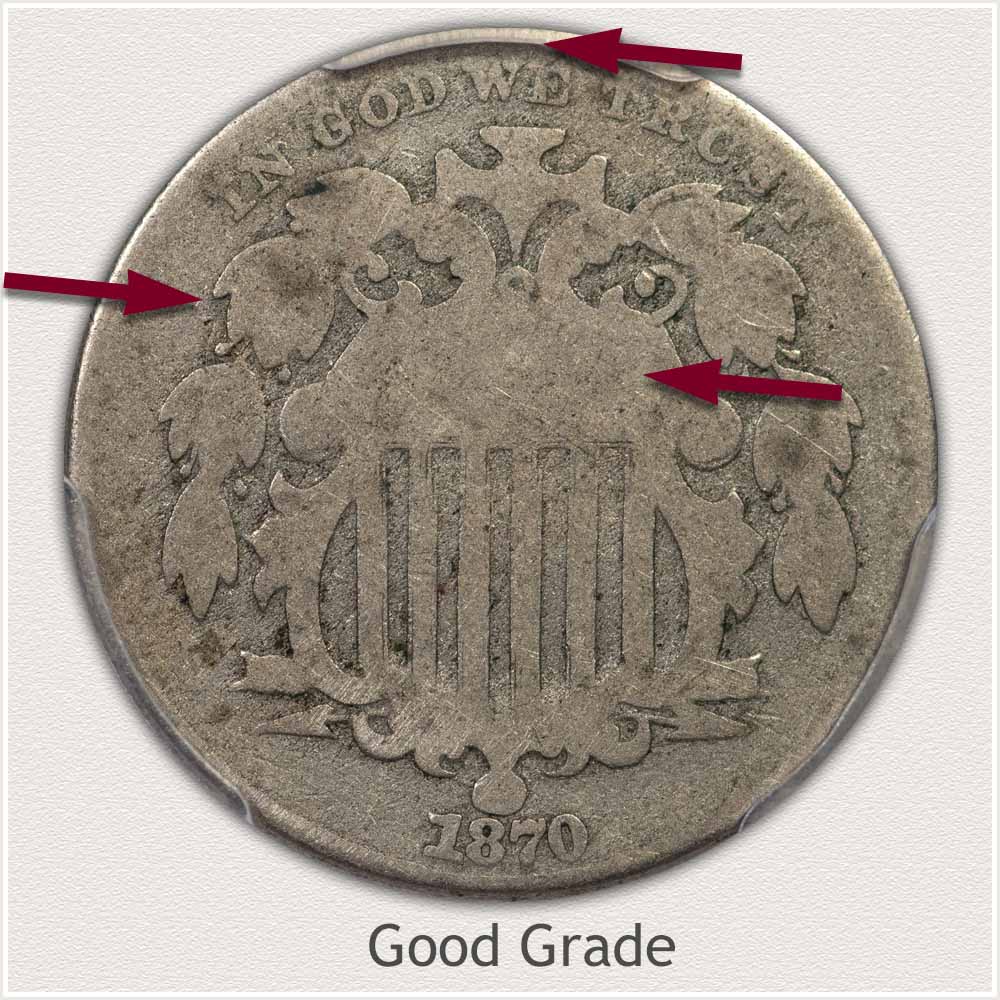
Good Grade: Large flat areas on major features defines a Shield nickel in "Good" grade condition. Viewing the example image, starting at the outer edge, most of the raised rim is missing. This lack of detail extends inward and fades parts of the motto IN GOD WE TRUST as well. The shield in the center is also flat, missing the fine detail of its frame. Additionally, all that remains of the olive branches and leaves are outlines. However, a properly graded coin requires a certain level of preservation to remain.
An important element, the rim protects inner design areas of the coin. A partially faded rim, not blending with the outer edges of the leaves, qualifies for the Good grade. Notice the slight merging of the rim with the motto in this condition level. A close examine shows parts of the rim are intact with a defining edge. Also, a strong date enhances eye appeal.
On either side of the shield, the leaves are worn completely smooth. This lack of inner detail within the leaf design identifies the Good grade. Importantly, outer edges of the leaves are not merged with the field of the coin.
The shield remains with few details. Worn flat is the frame of the shield and cross above. Only the vertical stripes are strong and clear. As with the leaves, strong outlines remain, well raised and bold. Full outlines of the shield and leaves meets the standards of Good grade Shield nickels.
A worn Shield nickel showing boldness towards the center is desirable in the market. A pleasing coin without noticeable marks or dark discoloration is a plus.
How to Video: Grading Shield Nickels
Step 3: | Special Qualities | First 5-Cent Nickel
Constant Demand for a "First Of" 1866 Nickel
Historical significance of 1866 Shield Nickels creates solid demand in the coin market. This is the first U.S. 5 cent coin minted in nickel. As the "first year" of a new category of coin, it enjoys added attention. Within the hobby, this special quality alone, ensures there is always collector interest.
This new coin was an addition to an existing five-cent piece. The very first five-cent denomination began prior to 1866. These were a silver coin introduced in 1792, the beginning of U.S. coinage. Production of the silver coin was continuous through 1866, ending in 1873.
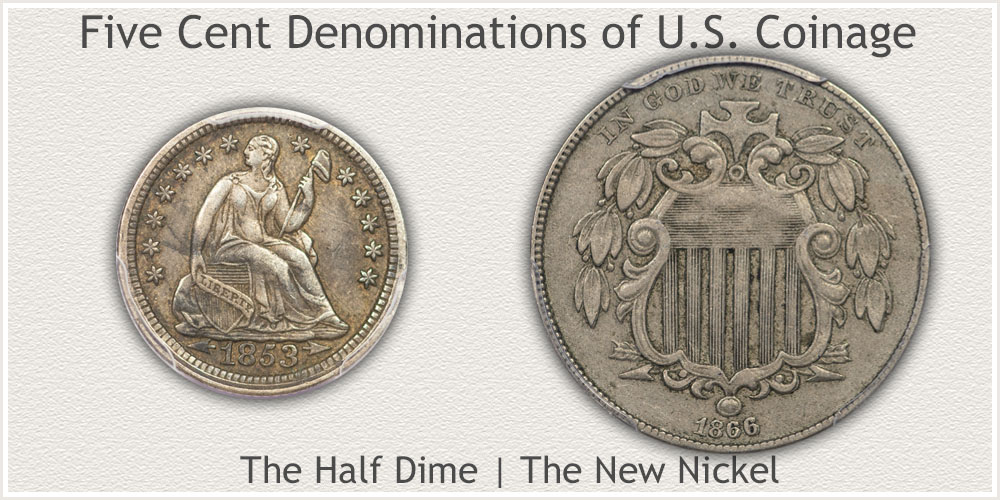 The 1866 Nickel Introduces the Second 5 Cent Denomination of U.S. Coinage
The 1866 Nickel Introduces the Second 5 Cent Denomination of U.S. Coinage
A five-cent silver piece is known today as the "half dime." The five-cent copper and nickel piece became known as a "nickel."
In May of 1866, the Philadelphia mint received the task of minting the new nickel coins.
Act of May 16, 1866
An act authorizing the coinage of five-cent-pieces
"Be it enacted by the Senate and House of Representatives of the United, States of America in Congress assembled,
That, so soon as practicable after the passage of this act, there shall be coined at the Mint of the United States a five-cent piece composed of copper and nickel,"
By June 30, 1866, production of nickels reached 1,324,000 pieces. By year's end, mintage totaled 14.7 million struck. Placed into circulation, most remained in use. Of the examples available today, heavy wear is the typical condition.
Reference the chart, note the premiums awarded to lightly worn or nicer 1866 nickels. Those set aside early are very popular as a representative of this historical coin. A very popular year within the series. A pleasing 1866 nickel in any condition quickly becomes part of a collection.
References
Finance U.S. Senate. Coinage Laws United States 1792 to 1894
https://archive.org/details/coinagelawsofuni1894comm/page/828/mode/2up
U.S. Mint. 1867 U.S. Mint Annual Report
https://nnp.wustl.edu/library/book/516168
U.S. Mint. 1866 U.S. Mint Annual Report
https://nnp.wustl.edu/library/book/514110
U.S. Mint. 1888 U.S. Mint Annual Report
https://nnp.wustl.edu/library/book/313
Coin Values | CoinStudy Articles
Date by Date
In Depth Shield Nickel Value
Shield Nickel Value | Complete Value Chart of All Years
A complete value chart lists all years, highlighting the scarce nickels. Introducing a nickel alloy five cent piece in 1866, Shield nickels are a first for U.S. coinage. Many dates in the series that ended in 1883, are scarce, if not rare.
How to Grade Shield Nickels | Video, Images and Descriptions
Old Shield Nickels span a wide range of condition. Close-up images highlight requirements to meet grading standards. Presented in the video are key features examined, pointing to the various levels of wear. Examine each coin using descriptions to accurately grade Shield Nickels.
Selling Coins | How to Realize the Best Value
With a planned approach, organize coins for the selling process. Gather important details defining and describing the coins. Estimate their offering value. Also, listings of dealers find those making a market for the coins offered.
Safe Coin Storage | Recommendations
Recommendations on basic supplies that greatly improve coin storage. Providing for safe handling, preserving value, and organizing your box of old coins. Safely house and store old nickels and maintain their value into the future.
Rare Nickels of the Twentieth Century
Rare nickels, for example, ones with a slight doubling of letters, occasionally "hide" in your box of old coins. Listed are scarce dates and mintmarks and how to identify them. High quality nickels are also in favor with today's collectors. Many nickels have become rare because of age and lack of availability.
★Coin Values Discovery finds 1866 Nickel Value and...
All old U.S. coin values. A full image and description index leads to value charts of U.S. coin series. Introduced is a step-by-step method to verify date and variety identification. How to judge condition is an important step covered within each series. As a significant feature of value, identify a coin's special qualities. Discover how much your box of old coins is worth.
